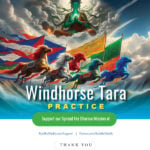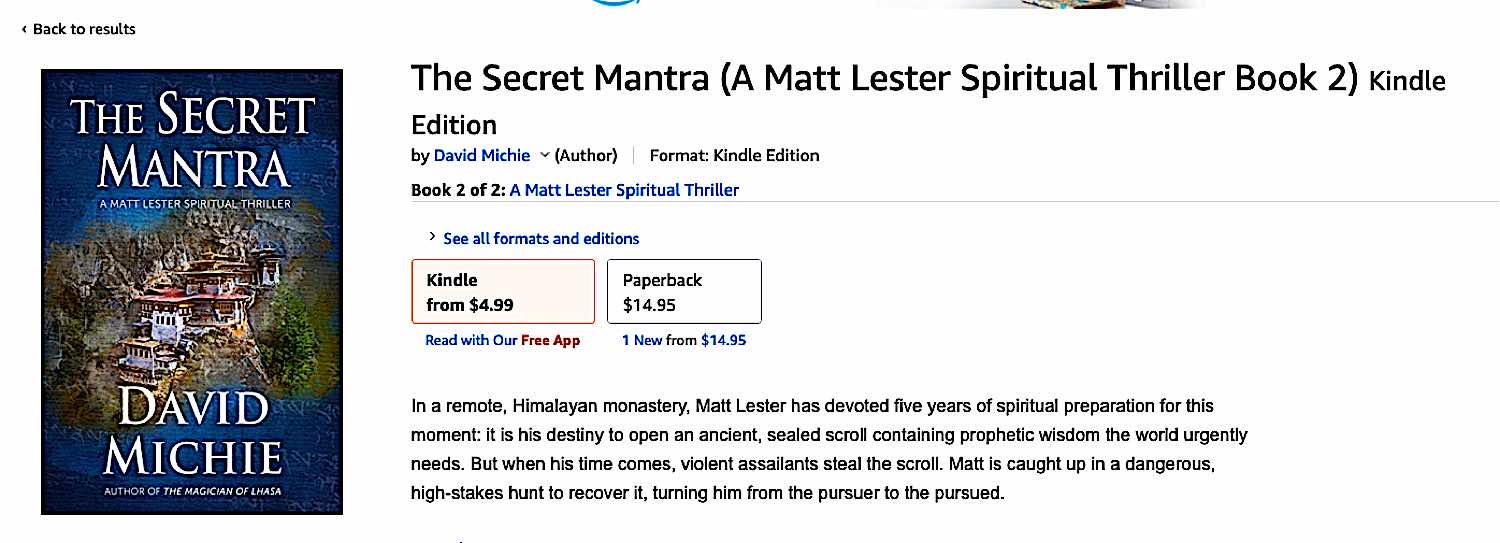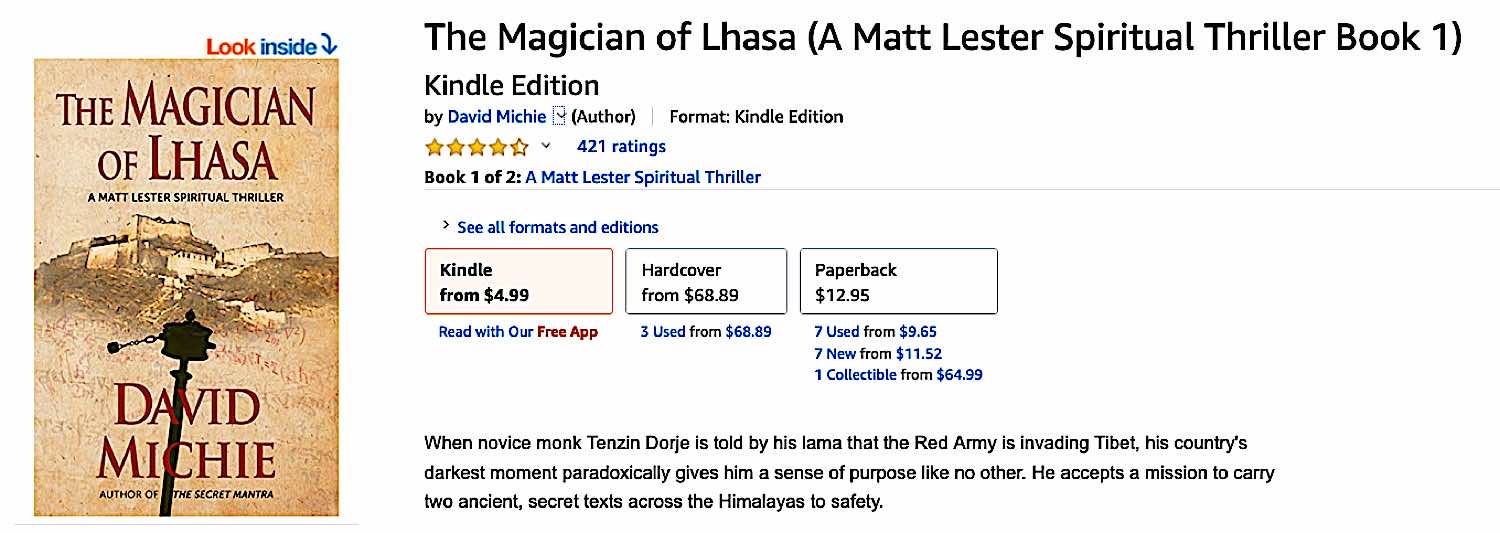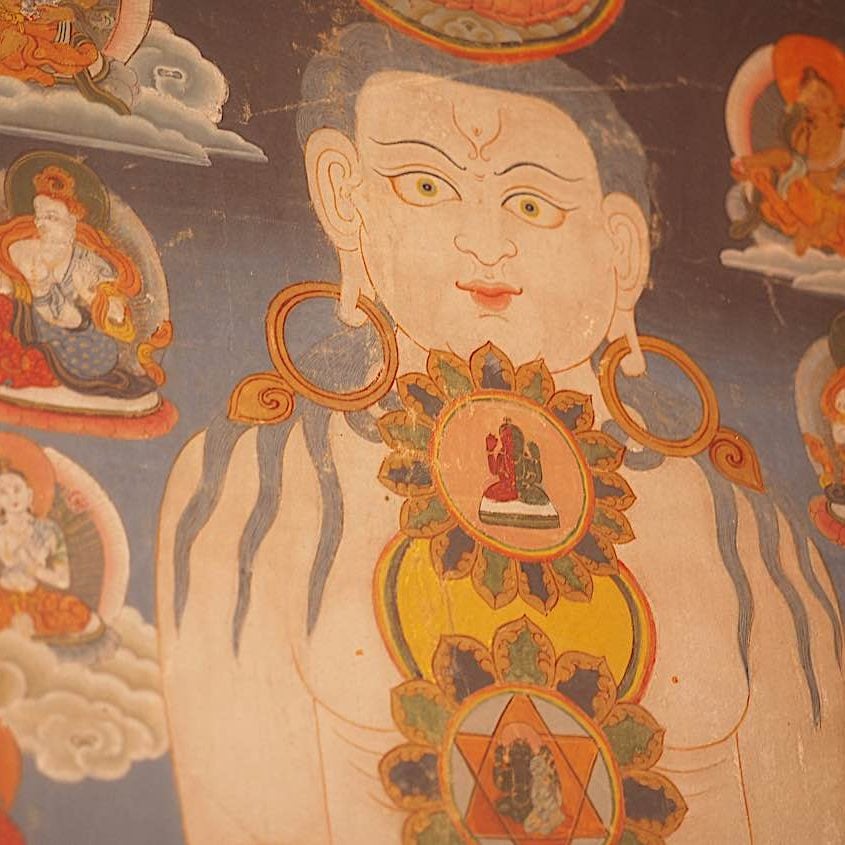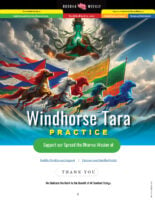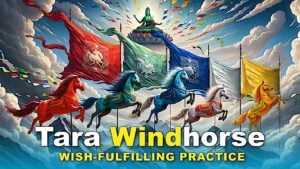Exclusive: read two chapters from international bestselling author David Michie’s new Tibetan Buddhist thriller “The Secret Mantra”
Editor: Many are familiar with David Michie’s international bestsellers, including his wonderful The Dalai Lama’s Cat series and numerous books on mindfulness, meditation and Buddhism (now in over 25 languages). One of my personal favorites is the thriller The Magician of Lhasa, an epic thriller spanning decades, and seamlessly blending the adventures of novice monk Tenzin Dorje in 1959, with modern-day scientist Matt Lester. So, I was delighted when David offered Buddha Weekly a chance to exclusively preview two of his chapters for our readers. (Please see both chapters below. We thought about a two-parter, but that would be too cruel.) You can read it all in one go. For the rest, you’ll have to wait for the official release on October 23 — although you can pre-order here>>

Synopsis of The Secret Mantra
In a remote, Himalayan monastery, Matt Lester has devoted five years of spiritual preparation for this moment: it is his destiny to open an ancient, sealed scroll containing prophetic wisdom the world urgently needs. But when his time comes, violent assailants steal the scroll. Matt is caught up in a dangerous, high-stakes hunt to recover it, turning him from the pursuer to the pursued.

On the other side of the world, the results of scientist Alice Weisenstein’s mind-body healing research are about to be revealed. Things take a sinister turn when her supervisor goes missing — and she realizes she is being followed. Guided by the lamas, Matt’s search for the scroll takes him to Alice. The pair become caught between powerful influences and escalating threats. Together they must decide who they can really trust.
The Secret Mantra weaves breakthrough science and spiritual insights into a heart-stopping storyline. It won’t just have you turning the pages. It will shake up your whole idea of who you are, and the transformation of which you are capable.
The Secret Mantra is book two of the Matt Lester Spiritual Thrillers, although you don’t have to read book one to enjoy it. To read about book one, The Magician of Lhasa, see this book page on Amazon>> or check out the synopsis below.
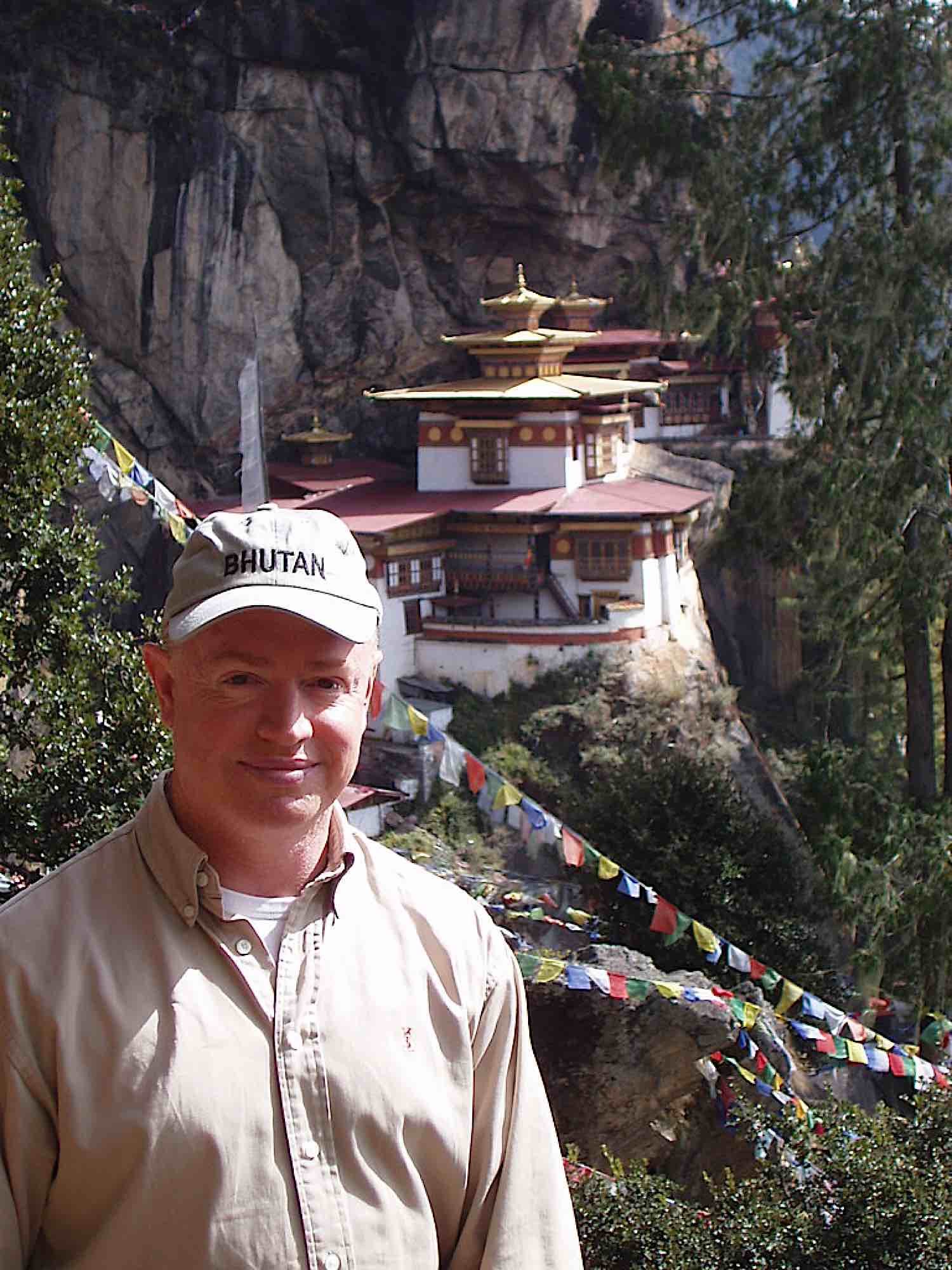
Biography David Michie
David Michie is the internationally best-selling author of The Magician of Lhasa, The Dalai Lama’s Cat series as well as the non-fiction titles Buddhism for Busy People, Buddhism for Pet Lovers, Mindfulness is Better than Chocolate and Hurry Up and Meditate.
In 2015 he established Mindful Safaris to Africa, combining wildlife viewing and meditation sessions in journeys to unexplored places, outer and inner.
- For more about his work go to DavidMichie.com>>
- David Michie Facebook page>>
- David Michie Youtube>>
Please enjoy these two chapters from David Michie’s new book.
Chapter One
Approach to Tiger’s Nest Monastery
Bhutan, The Himalayas
Dusk was already falling—and the last part of our journey was still to come. I knew about the dangers of nightfall on the mountains. How it was better to stop and wait out the darkness than risk a single, false step on sheer cliff tracks. But I didn’t want to stop—I’d been working towards this moment for too long.
‘Return on the full moon in May,’ Lama Tsering had told me, his expression bright with significance. ‘Then it will be time.’
When we’d set out from the valley floor earlier, our objective had looked like nothing more than a white speck on a distant rock face. Following the goat track that picked its way through the foothills, jack-knifing around increasingly precipitous crevices, many hours later we approached a place where the mountain curved sharply away revealing an altogether different view of our destination.
A few steps ahead, my guide Sangay reached the bend. And despite his familiarity with the scene, even he felt compelled to stop, gazing directly ahead as I scrambled up beside him. For there, only a hundred yards away, was Tiger’s Nest Monastery, magnificent and other-worldly, built on an impossibly narrow ledge jutting from a sheer rock face that plunged three miles to the valley floor. A series of high-towered buildings with elaborate wooden shutters, the monastery’s gold pagoda roofs glowed in the long, slanting rays of the sun, like a vision from some other realm of consciousness.
Between the buildings and where we stood was a chasm, giving the monastery an even more illusory appearance, like a mirage that might, at any moment, evaporate into mist. All that connected us were ribbons of multi-colored prayer flags crossing the gulf to the most remote monastery in the Himalayas.
Despite my aching legs, I felt an involuntary welling up of emotion—the powerful tug of homecoming. I had first come here five years ago in my early thirties, a Londoner and research scientist who knew little about the mysteries of the Himalayas. Five years later I was in no doubt that the most transformative experiences of my life had occurred in this special place. It was also the home of one of the most revered masters in the Tibetan Buddhist tradition—my kind and much-loved teacher, Lama Tsering.
After the briefest pause, Sangay gestured that we should continue. Lengthening fingers of darkness were already stretching towards the final approach to Tiger’s Nest, a narrow ledge cut into the dramatic zigzag cliff. Sangay was vigilant, directing me along the rock-strewn path. There was no margin for error. Legs shaking, I battled to place one foot in front of the other as the pathway tapered sharply and footholds were swallowed up in the deepening shadows.
Sangay pulled out a torch from his tunic and used it to point the way to safety. Concentrating so completely, step by step, when we reached the solid, stone walls of the fortified gatehouse it was almost by surprise. Suddenly the path widened to a much broader ledge, lush with grass.
I sank to the ground, stretching gratefully on the softness of the lawn. Sangay tugged on a brass chain hanging outside the massive, locked gates. Inside, a duty monk would alert Lama Tsering to our arrival.
‘Just in time,’ said Sangay, looking up at where the clear, May sky rapidly darkened.
I remembered my first visit, how I’d arrived bright with expectation and busyness. Excited about my purpose, I had expected Lama Tsering to be equally eager for me to fulfill my mission. Even though we had never met, I felt I had come to know him through Geshe-la, who was his student. I was in no doubt that my visit was significant. In his mid-nineties, I believed that Lama Tsering had been biding his time for much of the second half of his life to meet me.
Which only showed how much I had to learn! To begin with, it had been a full day before I was admitted to his presence. We might be in the most isolated monastery in the Himalayas but there were protocols. Finally ushered into his room at sunset on the day after I’d arrived, that first encounter had been unlike anything I had expected. I had already played out this scene in anticipation many, many times—Lama Tsering as the wizened, rheumy-eyed old monk greatly relieved at the appearance of me, the youthful Westerner, the Chosen One, to whom he could pass on the torch of some very specific wisdom.
Instead, the door opened onto a small room in which the monk, sitting in meditation, didn’t seem to be of any particular age. Greeting me with a smile, he gestured I should sit in front of him, before lowering his gaze. Several minutes had passed before he spoke, leaving me plenty of time to observe him. He had a longer face than the traditional rounded features of Tibetans, with prominent cheekbones and a high forehead. His hair, shaven close to the head, was dark, with only traces of grey. There was a gentle suppleness about his features and his arms, which were folded in meditative posture in front of him. His face and neck barely lined, there was an astonishing agelessness about him.
This being the first time I’d ever been in his presence, after scrutinizing his appearance, I took in the low table in front of him on which were placed several books, the small window behind him to the left, and the incense burner from which a steady blue-grey ribbon of smoke curled elegantly upwards. It was only then that I became aware of my own mental agitation. Here I was, in the presence of one of the tradition’s most revered masters, and where was my mind? Not settled in a state of ease—expansive, relaxed, and open to the wisdom of a guru. But instead looking around at his room, his books, the incense.
It was as if, without saying a word, Lama Tsering invited me into a different state of being. Lowering my gaze, I tried to meditate the way I had been shown by Geshe-la in recent months, focusing on being simply here and now, in the present moment. I felt my mind settle, to an extent that had eluded me in the past. Instead of constant thoughts and distracting chatter I felt myself slip into an awareness that was peaceful and benevolent. I had experienced some enjoyable meditation sessions in the past, but the sense of profound wellbeing I felt even that first time in Lama Tsering’s presence was so absorbing, so oceanic that I didn’t want it to end.
Eventually I sensed a movement and, looking up, I met his eyes.
‘I am very happy to see you,’ he folded his hands together at his heart and bowed towards me.
Unsure what to do, I reciprocated. Then feeling awkward in the unfamiliar stillness, I felt compelled to tell him how I’d met Geshe-la, and the sequence of events which had led to my coming here, as well as my eagerness to undertake the specific purpose for which I was visiting.
After I finished speaking, the silence that followed seemed to underline how unnecessary it had been. ‘Before starting on our important work,’ his expression was warm with compassion. ‘It is necessary to cultivate some meditative concentration.’
‘Yes, Lama.’
‘Knowledge is very good. But experience is better. A little practice and then we will be ready.’
I had guessed, from the way he said it, that his definition of ‘a little’ practice went beyond a couple of sessions.
I found myself engaged in an intensive study and meditation program that had started out at weeks, then stretched into months. More and more as I understood the magnitude of the truths I was being trained to reveal, my sense of purpose only grew stronger. Months had turned to years.
Lama Tsering had personally supervised my preparation, the culmination being the three-month solitary retreat which I had just completed.
“Return on the full moon in May. Then it will be time.” Time to pass on the very special knowledge of which he’d been custodian for the previous half-century but which, he had once told me, was much older than that. It had been kept secret for over a millennium, in exactly what form I could only guess, but secured in a hidden repository in the Himalayas for the time of its revelation—a time when it would be of maximum benefit to the world.
And I was the person chosen to reveal it.
Quite how it turned out to be me was something that still left me humbled. And tonight, in particular, filled with a sense of greater awe and anticipation than I had ever experienced. I could hardly believe that the time had finally come. The moment of transmission. The event, I realized now, to which my whole life had been leading me. And in accordance with the Buddhist view of rebirth, not only this lifetime, but many lives before it.
The monastery gates finally opened to reveal Kelsang, assistant to Abbot Lhamo. His usual cheerful features were drawn. ‘Welcome back, Matt,’ he inclined his head politely. Before saying, ‘The abbot will see you now.’
‘The abbot?’ I raised my eyebrows.
‘He has something to tell you,’ he frowned.
Sangay followed us into the monastery and returned to his quarters as Kelsang set an unusually brisk pace through the maze of corridors. Why wasn’t I being taken directly to Lama Tsering? Where was Dorje, Lama Tsering’s attendant, who I had expected to greet us? Was the abbot also to be present for the revelation?
Abbot Lhamo was standing alone on the worn, embroidered carpet in the middle of his office, his gaze calm and unwavering when I was ushered in. Tall, ascetic, highly regarded for his scholarship, he was considered remote by some, but this evening his expression was full of compassion.
‘Lama Tsering has been looking forward to your return today,’ he told me after Kelsang left the room, closing the door behind him. ‘Several times in the past few weeks he has spoken to me about it. A few minutes ago, when you arrived, Dorje went looking for him.’ He stepped closer towards me. ‘He found him in the main temple.’
The abbot took my left hand and held it between his. As he made that simple gesture, I felt my heart thundering. I suddenly knew exactly what he was going to tell me before he said it.
‘Matt, I am very sorry to have to tell you this sad news. Lama Tsering is dead.’
Chapter Two
It seemed impossible to believe: my kind guru dead? As I stood facing the abbot, an eternity passed. What he’d said made no sense at all. I felt so numb, for a while I could do nothing except stand in shock.
Lama Tsering had been the center of my world for the past five years. Everything in both our lives, it seemed, had been propelled by a special purpose, leading to this particular time and place, here and now. How could this be happening?
A short while later I was following Kelsang and the abbot. We passed through dimly lit corridors and up flights of stairs. What if Dorje had been mistaken? What if Lama wasn’t dead at all, but in a state of deep, meditative Samadhi? It wouldn’t be the first time such an error had been made.
The main temple at Tiger’s Nest was surprisingly small—not much larger than the dining room of an average home and far less regularly proportioned, being built around a cliff face. Its walls bulged around protruding boulders, the ceiling curved in a dramatic warp.
As we arrived, Jangbu, the monastery First Aid attendant, was on his knees. Dorje was standing next to him, holding a hissing gas lamp. On the floor, Lama Tsering looked small and frail, a bundle of bones in red robes.
I knelt down immediately, studying those familiar features, wanting so much to find a sign that this wasn’t what I’d been told. But the moment my knees touched the stone floor, I knew. Eyes closed and features expressionless, Lama’s face was a pale reminder of what had once been. The consciousness that had defined him with such immense benevolence in life was no more.
Jangbu gently rolled the body so he was lying on his back. The left side of his head was dark, the skin of his cheek grazed. The movement of his body caused Lama’s wooden mala beads to rattle from his robes onto the stone. The abbot quickly swooped to collect them, handing them to me in a fluid gesture. ‘I am sure Lama Tsering would have wanted you to have this.’
Wordlessly I accepted the rosary with both hands, pressing them in prayer mudra to my heart. Even in my numbed state, the significance of the abbot’s gesture wasn’t lost on me.
As Jangbu studied the left side of Lama’s head, concentrating on the graze to his face, Dorje murmured something. Placing Lama’s head back on the floor with infinite care, Jangbu quickly rose, seizing the gas lamp and holding it to where Dorje was gesturing towards the wall. The abbot and I both stepped forward, staring at the same spot.
It was evident that Lama’s head had struck the wall with some force. This was not the mark of an elderly man falling to his side in the throes of a seizure.
The abbot stepped away, his eyes meetings Dorje’s with an expression I had never seen before. A look of such darkness, such deep foreboding, I felt a chill pass through my body.
‘Were there visitors today?’ he asked.
‘Only two this afternoon, Abbot. They were Khampas.’
The Khampas! Massive, fearless men from the Kham province of Tibet, it was said that Khampas had been the fiercest warriors in Genghis Khan’s Mongol army. Sangay and I had passed by two of them, less than an hour from the monastery, dark shadows moving with unusual haste. I explained how we’d seen them, clambering across a precipitous ledge. We had thought they were descending quickly on account of the failing light. Now I realized the true reason for their furtive maneuvers.
Looking down at my lama’s diminished form, I wondered about his last moments of consciousness. Was it possible that he’d been alone and defenseless against two such formidable assailants? But why would they treat a frail, old monk like this?
In the spluttering sepia light, I looked towards the altar. On arriving at Tiger’s Nest, over sixty years before, Lama Tsering had presented the abbot a statue of a Buddha called Sangye Menla, which he had brought all the way through the Himalayas on his back. The statue, which had once occupied pride of place on the altar of his own monastery, was no more than eighteen inches tall, but was both ancient and exquisite, dating back to the ninth century. Before the Chinese invasion, despite the many temples and countless beautiful images of Sangye Menla throughout Tibet, this particular statue, belonging to the temple of Zheng-po monastery, was revered as the most auspicious. Sacred and beautiful in ways which went beyond words, the mere sight of him would bring tears to the eyes of some devout Buddhists encountering Sangye Menla for the first time.
Even more fascinating were the stories told of those who had meditated in his presence. It was said that people who sat with strong concentration in front of Zheng-po’s Sangye Menla would be sure to receive visions of him in their sleep and rapidly develop in their practice, acquiring special powers, especially the gift of healing. For Sangye Menla, translated from Tibetan means Supreme Healer, or Medicine Buddha, sometimes also King of the Lapis Lazuli Light.
Sangye Menla had been among the greatest treasures to leave Tibet. Which is why the abbot of Tiger’s Nest, receiving this peerless statue, had decided that it should occupy the main temple, for the benefit of resident monks as well as visitors who made the difficult pilgrimage up the mountain. There he had remained, the jewel in the crown of the world’s most famous Buddhist monastery.
Until now.
Because as I stared at the place he usually occupied, to the left of the altar, there was only an empty space. The reason for Lama Tsering’s death became instantly clear. And as the others followed my gaze, they understood too.
At the abbot’s request, I followed him. Leaving Jangbu and Dorje to deal with Lama’s body, we returned to the abbot’s office where he dispatched monks with urgent messages. A vigil for Lama Tsering was to be held, with mantras chanted through the night. At dawn, the whole monastery was to attend a fire puja, or purification ceremony.
The abbot arranged for Sangay to set out at first light with a letter for the police station in Thimphu, reporting the crimes of murder and theft.
As the last messenger left his office, Abbot Lhamo got up from his desk and, pushing aside a curtain, stepped into a concealed room that led off his office. I heard him move around for some time, the opening of drawers and rustle of papers, before he reappeared with an envelope in his hands. It was fashioned from a thick, fibrous paper I’d never seen before, and both longer and wider than standard.
‘This is a duty I’d hoped never to have to carry out,’ the abbot said. ‘Lama Tsering lodged this with me the day he arrived at Tiger’s Nest. He left the instruction that if he died before revealing certain information, this was to be passed onto the chosen recipient.’
I glanced at the ancient envelope before our eyes met, and he responded to my unspoken thoughts, ‘What’s happened to Lama Tsering is a personal tragedy. Now, of all times, when he was about to fulfill the responsibility he had been waiting all these years to accomplish.’
‘The May full moon,’ I murmured.
‘He told me about the significance of your return. Try not to grieve for Lama Tsering. He was one of our most realized practitioners. Rest assured he is no longer limited by the constraints of an old, human body. He abides in the boundless radiance of the dharmakaya.
‘What is of the utmost importance now is to achieve the purpose for which Lama Tsering was preparing you—not just for your own sake, but for the sake of countless living beings. This is now your responsibility, your special privilege. The lamp is handed on.’
For some moments the abbot stood, eyes closed, softly reciting a mantra. Then with all due solemnity, and with both hands, he handed the envelope to me.
With my head bowed, I accepted it with both hands, and as he looked on, I turned it over. The aging sealed flap on the reverse side was desiccated and peeled away easily. Inside was a single page, also a thick parchment of a kind I’d never seen, folded twice. A letter from a different age. I immediately recognized Lama Tsering’s handwriting. Written in English and printed carefully, while the ink had faded, the short note was still clearly legible.
In 1959 a sealed scroll was brought from Tibet to safety. The scroll was one of the most precious texts, not only of our lineage, but of the entire Tibetan Buddhist tradition. Discovered in a Tibetan cave in which the glorious Padmasambhava was known to meditate in the 8th century, it is believed to be a terma, composed by Guru Rinpoche himself.
As I read Lama’s words, I felt overwhelmed. While I had an inkling of the origins of the secret I was to reveal, it was quite another thing to have written confirmation. Padmasambhava. He was one of the central historical figures in Tibetan Buddhism! Nearly every temple in Bhutan had him as their central Buddha statue. He was more famous in these parts than any other yogi for the prophecies, many of which he had stored in termas, or hidden scrolls. The most famous of all Tibetan Buddhist prophecies had been composed by him:
In the time that the iron bird flies,
And horses run on wheels,
The Tibetan people will be scattered across the face of the earth
like ants,
And the Dharma will come to the land of the red-faced people.
Written almost a thousand years before cars or airplanes were invented, Padmasambhava had foreseen both tragedy for Tibet and the benefit to Westerners—the red-faced people.
During the years I was at Zheng-po I had heard the story that Lama Tsering had found a sacred scroll in a hidden cave in the mountains—a highly auspicious discovery. I’d asked him about it only once. With typical modesty he’d just shrugged his shoulders and said “yapping dogs”—his short-hand way of dismissing all forms of speculation.
The Office of His Holiness, the Dalai Lama, has chosen you to open the scroll and reveal the text within, for the benefit of all living beings without exception.
There, in a single sentence, was my purpose defined. It was an astonishing statement—almost unbelievable. Of all the people in the world, of all the many more knowledgeable and wise practitioners within Tibetan Buddhism, how was it that I, an unenlightened Westerner, had found myself in a position of such immense trust?
But exactly where was the scroll? Lama’s letter had only one short paragraph left:
Please show this letter to the abbot of Tiger’s Nest Monastery. By these words I grant you the authority to receive the scroll. For safekeeping, I lodged it in the main temple, inside the statue of Sangye Menla.
May all beings have health, happiness, and long life!
Signed: Lama Tsering Gyatso at Tiger’s Nest Monastery
October 1959.
I brought my face to my hands and groaned. I had no words. I couldn’t even think. As the abbot stepped towards me, I handed him the letter.
My purpose as the one to reveal Padmasambhava’s terma had seemed wildly improbable. But the theft of the Sangye Menla statue made it impossible. The Khampas would already be on the lower slopes of the mountain. With no way of making contact with the outside world from Tiger’s Nest, by the time Sangay got word to the local Police, both thieves and the statue would be long gone. I sat, hugging myself in the chair.
After a pause I heard the abbot say, ‘You’ll have to get moving.’
Having returned to his desk, he was opening a drawer and taking out a small box of cards.
‘Moving?’ I blinked.
Flicking briskly through the cards, he found the one he was looking for, took it from the box and was copying details onto a slip of paper using an ancient fountain pen.
‘I don’t hold out much hope from a police investigation,’ he spoke evenly as he continued writing. ‘So we’ll have to do this on our own.’
‘Do we even have a hope—’
‘Self-reliance!’ he shot me a glance, expression severe. ‘It’s your job, your purpose, on behalf of many living beings. This is no time to go soft! Tiger’s Nest is where the statue belongs. The hermitage is where the terma must be revealed—nowhere else on earth!’
In the past, Lama Tsering had hinted that the terma – treasure – may be revealed in the hermitage, an extraordinary place kept secret throughout the whole of Tiger’s Nest’s existence. This was the first time I’d been told of the plan directly.
‘I wouldn’t know where to start,’’ I shrugged. Having just emerged from a three-month retreat, the idea of chasing after the two Khampas was overwhelming.
‘Kathmandu,’ Abbot Lhamo was firm. ‘The regional hub. Everything goes through there, especially—’ he held my eyes. ‘Stolen antiquities. You’ll have to use your initiative. I also have one lead from a while back. A well-connected gentleman.’
He gestured me to approach.
‘Go down the mountain with Sangay tomorrow at first light. There’s an afternoon flight from Paro to Kathmandu.’
With a firm flourish he applied a rolling ink blotter to the paper on which he’d just been writing. He passed it to me.
Looking down, I read the name next to a phone number. ‘Grayson Dalberg?!’ I was incredulous.
‘Mr. Dalberg is, how can I say … a little eccentric? Controversial. But he knows much more about the trade in Buddhist statues than anyone else in the world.’ Abbot Lhamo pushed back from his desk.
‘You are referring me to him, even though …?’ I could hardly believe what he was suggesting.
The abbot pushed the chair back from his desk, slowly stood, and drew himself up, meeting my eyes forcefully. ‘If anyone can help us find and return the statue of Sangye Menla to its rightful place—’ the abbot spoke with the authority of his office, ‘—it is he.’
- The Secret Mantra: Order on Amazon or from your local bookstore!
Synopsis of book one in the series
When novice monk Tenzin Dorje is told by his lama that the Red Army is invading Tibet, his country’s darkest moment paradoxically gives him a sense of purpose like no other. He accepts a mission to carry two ancient, secret texts across the Himalayas to safety.
Half a century later, in a paradox of similarly troubling circumstances, Matt Lester is called upon to convey his own particular wisdom as a scientist, when Matt’s nanotech project is mysteriously moved from London to a research incubator in Los Angeles.
Tenzin and Matt embark on parallel adventures which have spine-chilling connections. Tenzin’s perilous journey through the Himalayas, amid increasing physical hardship and the ever-present horror of Red Army capture, is mirrored by Matt’s contemporary, but no less traumatic challenges, as his passionate relationship with his fiancée, Isabella, and his high flying career undergo escalating crises.
It is at the moment when both Tenzin and Matt face catastrophe that their stories converge, spectacularly transforming our understanding of all that has gone before.
- For book one in the series, visit Amazon or your local bookseller.
Other books by David Michie
Visit David Michie’s author page on Amazon for some of the many wonderful books by this prolific author>>
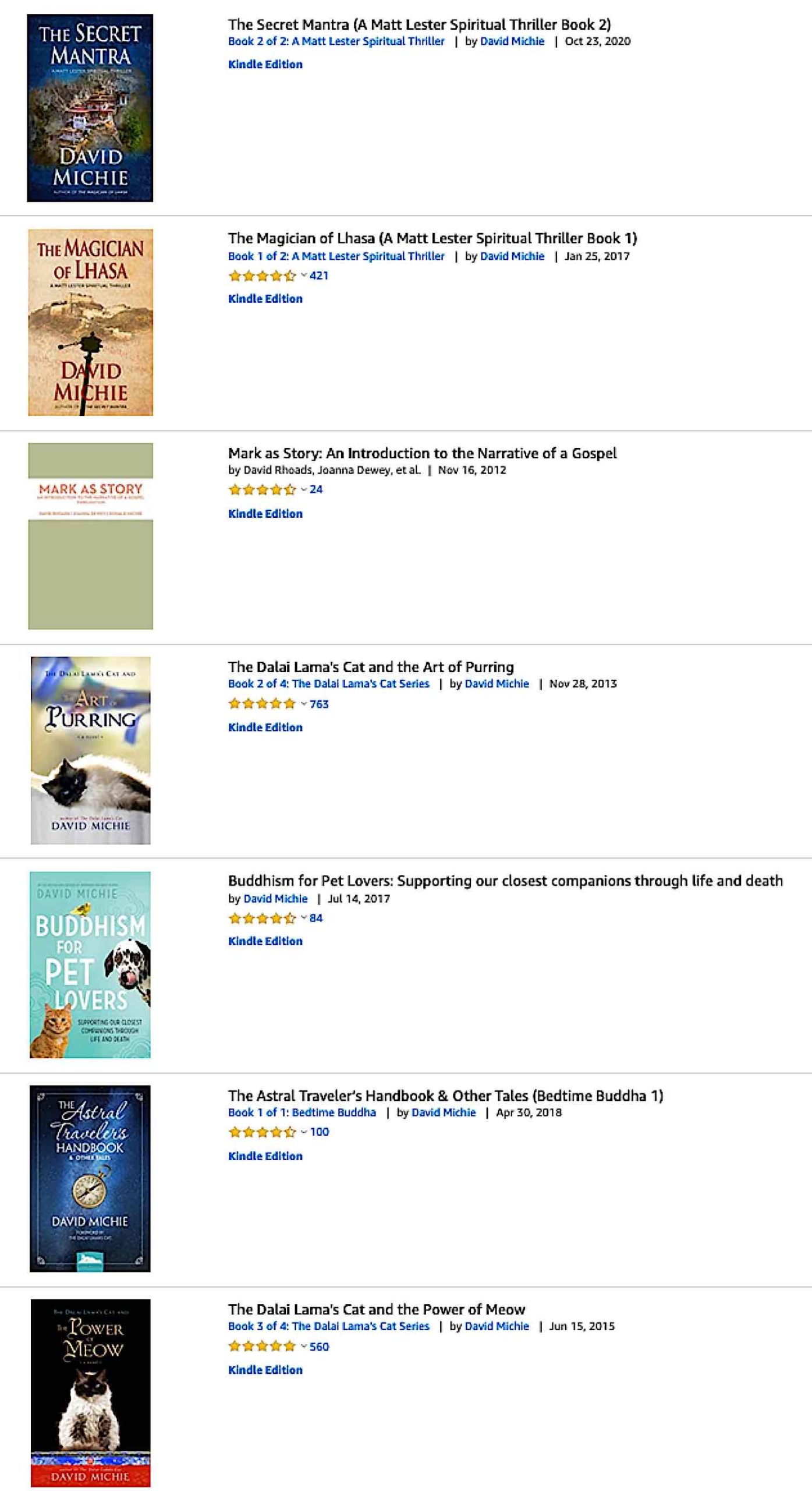
More articles by this author

Guru Rinpoche is ready to answer and grant wishes: “Repeat this prayer continuously” for the granting of wishes
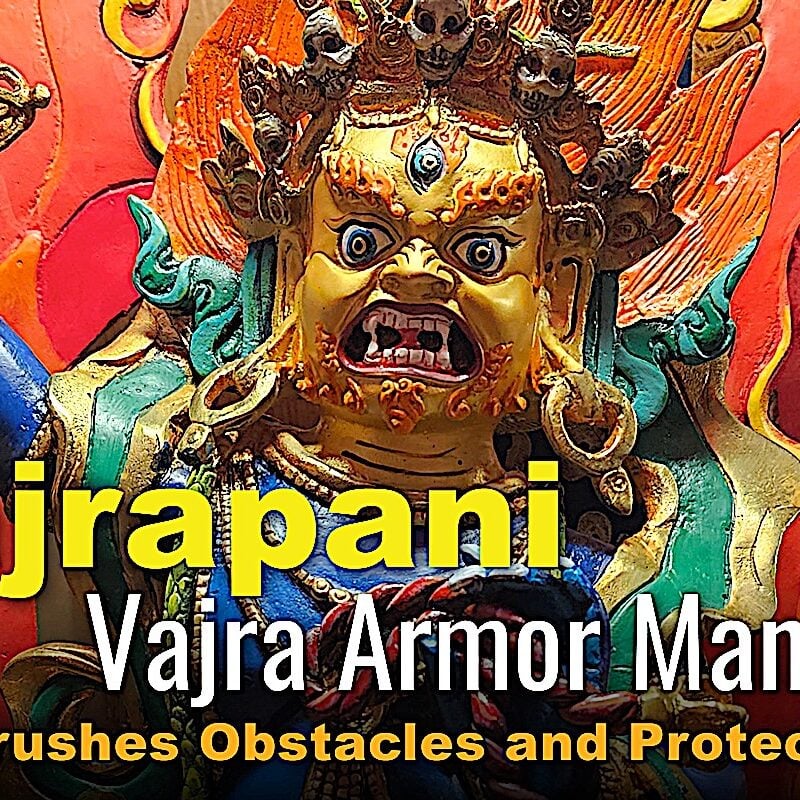
VIDEO: Vajrapani Vajra Armor Mantra: Supreme Protection of Dorje Godrab Vajrakavaca from Padmasambhava
Search
Latest Features
Please support the "Spread the Dharma" mission as one of our heroic Dharma Supporting Members, or with a one-time donation.
Please Help Support the “Spread the Dharma” Mission!

Be a part of the noble mission as a supporting member or a patron, or a volunteer contributor of content.
The power of Dharma to help sentient beings, in part, lies in ensuring access to Buddha’s precious Dharma — the mission of Buddha Weekly. We can’t do it without you!
A non-profit association since 2007, Buddha Weekly published many feature articles, videos, and, podcasts. Please consider supporting the mission to preserve and “Spread the Dharma." Your support as either a patron or a supporting member helps defray the high costs of producing quality Dharma content. Thank you! Learn more here, or become one of our super karma heroes on Patreon.
Lee Kane
Author | Buddha Weekly
Lee Kane is the editor of Buddha Weekly, since 2007. His main focuses as a writer are mindfulness techniques, meditation, Dharma and Sutra commentaries, Buddhist practices, international perspectives and traditions, Vajrayana, Mahayana, Zen. He also covers various events.
Lee also contributes as a writer to various other online magazines and blogs.




